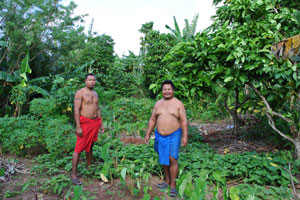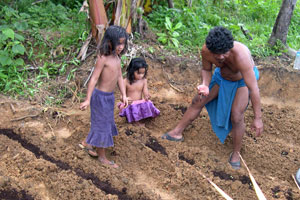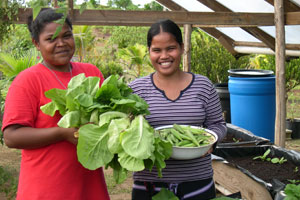Changing climate patterns and the associated ill-effects are inherently severe in the Federated States of Micronesia and are perhaps the most pressing challenge facing the nation as it seeks to nourish its people. Decreased rainfall and rising sea levels are disturbing the traditional taro patches, low-lying forestry systems and other ecosystems. In Yap, one of Micronesia’s states, combining traditional farming and scientific insights has brought fresh promise for biodiverse and sustainable food production systems.

The population of the fourteen remote low-lying atolls of Yap has relied on traditional subsistence agriculture since ancient times.
Central to their lifestyle were a range of traditional biodiverse food production systems that provided sustainable food production in the widely differing ecosystems of these tiny atoll islets.
These systems included productive agroforests, intermittent tree gardens, kitchen and backyard gardens, raised-bed farming and wetland taro patches. These systems maintained their own soil fertility, crop protection and high cultivar diversity, providing the island communities with a variety of foods that made them among the most self-sufficient and well-nourished people in the region. However, the situation has changed over the last few decades as the effects of changing climate patterns have begun engulfing these tiny island ecosystems.
A dismal picture

Today, these atoll communities are among the most economically and environmentally vulnerable groups in the region. Environmental, economic and social hardships have forced communities to migrate to Yap Proper, Yap’s main island, in search of better livelihood opportunities – particularly after the devastation caused by typhoon Sudal in 2004. Upon moving to Yap Proper with dreams of improving their living conditions, these environmental immigrants often faced a lack of jobs and an unfamiliar and challenging environmental setting. Many of them relocated to Gargey settlement, a piece of previously uninhabited barren land on Yap Proper, provided to them by the government.
Atoll communities had no choice but to move to this “safe haven”, but this bought its own problems. To increase their self-reliance and insure their families against risk, they attempted to recreate their traditional farming systems, using the plants and seeds they had brought with them from the atolls. However, it was not easy to establish food crops on the predominantly volcanic red soils whose fertility had been depleted by the years of slash-and-burn and shifting cultivation practiced by the early settlers. Much of the soil in and around Gargey settlement was degraded and depleted of nutrients and biota.
Cultivating success
Since 2006, the Co-operative Research and Extension of the College of Micronesia-FSM, with financial assistance from the United States Department of Agriculture from 2006-2012, has been providing a comprehensive outreach assistance programme to the displaced atoll communities.
The Gargey inhabitants received training in volcanic soil management and a spectrum of small-scale food production methods. Providing hands-on training and workshops, facilitating group discussions, connecting farmers with each other, and distributing seeds and supplies, we placed a strong emphasis on establishing, promoting and disseminating traditional food crop systems by integrating scientific knowledge.
The most important strategy for managing these degraded volcanic red soils and bringing back the soil biota was to build up nutritious topsoil using composted chicken manure, plant-derived compost and mulch. We encouraged farmers to add lime to the soil, which increased the soil pH and reduced aluminium toxicity, while providing the calcium that the plants needed. As the highly alkaline atoll soils are different from the highly acidic upland soils of Gargey settlement, the resettled farmers needed different management strategies than they had practiced in their traditional systems. Improving the soil was the first step for farmers to bring back the biodiverse farms they had left behind.
To complement their traditional knowledge in establishing small-scale vegetable gardens and food production systems in their new environment, we demonstrated different composting methods and small farm methods based on modern scientific principles. These methods included small plot intensive farming (SPIN), micro-gardens, raised beds, container home gardening, agroforestry and integrated farming with livestock. Broadening local indigenous knowledge on soil management and food production by incorporating scientific knowledge was essential given the physical and chemical properties of the volcanic red soils. Much emphasis was placed on synthesising traditional knowledge and modern science.
From barren land to biodiverse home gardens
After several crop cycles we noticed that traditional and science-based knowledge, along with human ingenuity, had helped the communities to successfully re-establish biodiverse home gardens. Sustainable practices such as mulching the soil and agroforestry have increased the climate resilience of these smallholder systems. Today, these home gardens have become sustainable food production systems containing a mixture of traditional root crops, fruit and nut trees and vegetables.
Despite the different soil conditions and management at Gargey settlement, most of the original crops from the atolls are cultivated using adapted traditional practices. An assessment of crops in the landscape of Gargey settlement after nine years of human habitation revealed a significant development of agricultural biodiversity. The settlement today harbours 55 households from seven atoll islets in an area of approximately one square kilometre. In this area, the Gargey community grows about 40 different food crops and over 100 different varieties/cultivars, including fourteen varieties of taro (swamp taro, Honolulu taro and sweet taro), seven types of banana, seven varieties of yam and three varieties of cassava. Over 90% of the crops currently established in the settlement originate from the atolls or Yap Proper, which were brought along, exchanged, bought or otherwise shared among farmers.
The home gardens of Gargey settlement vary from small backyard gardens containing a few vegetables to large agroforestry plots with many species. Individually, some of these home gardens may not be true repositories of agrobiodiversity in the scientific sense, but collectively across Gargey settlement they provide a significant overall diversity of traditional root crop varieties and cultivars, fruit trees and vegetables. Over the years, the Gargey community has developed an intimate knowledge of useful plant characteristics (especially of staple crops like taro, cassava and yam), such as their ability to grow in volcanic red soil, their susceptibility to pests and diseases, nutrient requirements, and their ability to serve as ornamental plants in ceremonies.
Cultural and socio-economic factors have profoundly influenced crop diversity. Families engage in food production for subsistence, but these home gardens, multifunctional agro-ecosystems, are also important social and cultural spaces where knowledge related to agricultural practices is transmitted. A return to home gardens modelled on traditional systems holds a particular cultural and social significance for the displaced population, as they have been able to re-establish the multifaceted benefits that traditional agro-ecosystems have provided them with for millennia.
Ever since the atoll communities began migrating, the settlement has become a multi-ethnic centre of cultural diversity endowed with unique cultures which have brought a rich diversity of crops with them. Even though they originate from different atoll islets, the displaced communities live in harmony in the Gargey settlement. At present there is not a shortage of land on Yap Proper, although amended cultivable fields with improved soil conditions are limited. The community also faces the challenges of extreme weather conditions and limited government support.
Expanding success
Following the successful habitation of Gargey settlement, two other locations on Yap Proper are currently being settled by migrating neighbouring atoll communities. Our extension programme’s success with Gargey community has enabled us to provide similar outreach assistance to these new immigrants. We are expanding our programme and experimenting with biocharbased soil remediation, testing the effect of biochar on Yap’s degraded volcanic soils.
Against the backdrop of the International Year of Family Farming, it is pertinent to raise the profile of displaced family farmers. The experience of Gargey settlement shows that there are solutions that ensure nutrition and food security, improve livelihoods, protect the environment, enhance crop diversity and promote sustainable development in a rural setting.
The solutions offered at Gargey were well accepted by the communities because they built on their traditional practices. In addition, these interventions help communities achieve their short term needs of food security in an urgent situation, while building a lasting and environmentally favourable solution.
We continue to promote the wide participation in food production and restoration of agrobiodiversity, of farmers and scientists working together. Our outreach and education efforts can be easily replicated in other locations in the western Pacific Islands where degraded red soils are predominant. This increases the importance of this agricultural intervention for other threatened island communities. This said, the uniqueness of each island must be at the forefront of any adaptive strategy.
Murukesan Krishnapillai and Robert Gavenda
Murukesan Krishnapillai is a Research Scientist/Extension Specialist with Cooperative Research and Extension, College of Micronesia-FSM.
E-mail: vazhaveli@hotmail.com
Robert Gavenda is a Resource Soil Scientist for USDA-NRCS (Natural Resources Conservation Service) based in Guam. The programme was supported by the USDA and the College of Micronesia Land Grant Program


